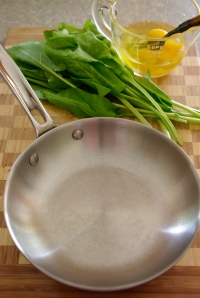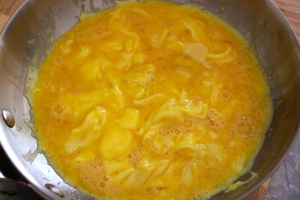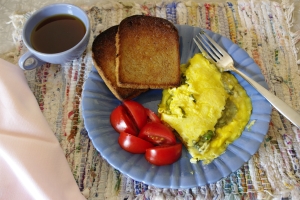I made a new friend today: sorrel. I had never tried sorrel before, and it was only last week that I first saw it at the co-op. Perhaps it has been there in years past, but I had never noticed it. I had no idea what it tasted like, and no idea what I should do with it, but I bought some anyway, not being sure when I might see it again.
I had heard of sorrel, of course, and I vaguely associated it with watercress, although with no definable connection. I had a vague stereotyped notion that people who like watercress also like sorrel. I don’t know where this idea came from, but more likely than not, someone suggested something to this effect in a magazine article or in a cookbook I once read. However the idea arrived in my head, I reasoned that because I love watercress, particularly on egg salad sandwiches (and on cucumber sandwiches too), so I would naturally like sorrel too. I like spinach. What’s not to like?
I put it in the vegetable bin in the refrigerator, and promptly forgot about it. These things are apt to happen, even to me. It is rare that I let something spoil in the refrigerator, but it has happened on occasion. So on Sunday, when I found myself back at the co-op, I bought a second bunch, just so I could say that yes, I did indeed try it. I still had no idea what I was going to do with it, but I was determined to do something.
I spent some time yesterday thinking about sorrel, in a rather abstract way. This kind of thinking was clearly related to the idea that people who like watercress also like sorrel. I imagined a person very knowledgeable about sorrel, and what this person might be like. I determined that it would indeed be someone who likes watercress. It would be someone who also knew about wild mushrooms. An herbalist, for certain. I imagined this person living in a stone cottage, a very old stone cottage, on the edge of a meadow, not far from a pleasant stream. I imagined a wicker basket full of eggs in the kitchen, herbs growing on the windowsill, herbs growing outside the kitchen door, wildflowers filling the meadow, little brown rabbits happily doing what rabbits do (which in this case was simply being fluffy and adorable), with butterflies flittering all around and honey bees hard at work. I imagined jars of honey that would simply appear in the kitchen without requiring a beekeeping suit, wonderful old crockery and wooden utensils and sturdy basketry, Wellies that never wore out, all jolly good health and amber sunshine, and not a mosquito to be found anywhere. This person would also like asparagus and potatoes and cheeses, and was therefore likely to make a variety of quiches with the delicious eggs that appeared as magically as the honey. In all probability this person was a vegetarian, or very close to it, as the whole business of butchering and selling meat was not in keeping with the grandly pastoral vision I was creating. I went on thinking this way for quite some time, very circular thoughts, quite lost in this beautiful world that was entirely without plastic. (I was very fond of the “no plastic” part.)
I liked this vision so much, I made a lot of lists, lest I should forget all the wonderful things that made this world my utopia. The lists were intended to help me create this fantasy insofar as I could, however, I came to an end when I was unable to reconcile my vision with my obvious dependency on the internet. I could easily fathom giving up my car for a bicycle, but no email? No Wikipedia? No Netflix? No imdb? No NYT online? That’s why all utopias fail.
After all that, I didn’t actually do anything with the sorrel.
Today being Wednesday, and “sorrel” being an item on my to-do list, I had to figure out something to make that had sorrel in it. So naturally, I looked it up online. (If I can’t live in a pastoral paradise, it is only fitting that I should avail myself of the dystopian tools at my disposal.) I was quite surprised to learn that sorrel was described as sour, “mouth puckering,” and with a flavor not unlike rhubarb. I was led to believe by Hugh Fearnley-Whittingstall (of River Cottage fame whom I credited with being a reliable source) that sorrel was best paired with eggs, potatoes, and oily fish. This was very interesting. Not at all what I expected, but very interesting all the same. It was also generally referred to as an herb, not a vegetable as I had anticipated.
So, for the very first time, I went to the refrigerator to actually taste the sorrel. That’s when I realized that the first bunch of sorrel that I purchased hadn’t spoiled. It was still bright green and fresh and lovely. Thus, I now had two bunches of sorrel to cook, since I had been given the impression that the sorrel I had was too large to go uncooked into salads. The flavor was lemony and tart, very much like rhubarb, and I could easily see it being paired with fish. I was happy to know that I liked it and that it wasn’t bitter.
It still being morning, there was but one thing to do, and that was start at the beginning. A sorrel omelet would be for breakfast, and fish with sorrel sauce for supper. I have indeed had a very sorrel sort of day.
The procedure for making an omelet, whether it is sorrel or chive or spinach or cheddar or any other filling of your choice, is always the same. I will describe this morning’s omelet because that is the one I photographed, but you may substitute any filling you desire.

I have never had an omelet stick to this pan. It is an exquisite pan, purchased on sale for $50. I use it two or three times a week, and I expect to have it for the rest of my life. I love this pan, and I reserve it solely for making omelets. Nothing but eggs has ever been cooked in this pan. As it should be.
As far as I’m concerned, recommending a nonstick pan is a way for a writer of a recipe to hedge his bets against the recipe failing for another cook. The French were making omelets for centuries before the manufacture of PFOA (also known as C8). If an 18th C. French peasant can make an omelet without resorting to carcinogenic chemicals, then so can I.
The trick with omelets is to have the pan be hot before you add the eggs. On my stove, the setting “medium” is divided into four sections by three lines. I have found through trial and error that if I set the dial at the first line of medium (on the “low” side of “medium”) it is just right. Unfortunately, this stove is electric, so the preheating time can be considerable. It has become my habit to start heating the pan while I beat the eggs.
For myself, I usually use only two eggs, but my son requires three. In this example, I did use three, but that is because I accidentally dropped one and it cracked and needed to be used right away.
I whip the eggs with a fork, incorporating as much air as I can. I also add just a teaspoon or two of water. It has been told to me that when the water hits the hot pan, it creates steam and makes the omelet fluffier. My objective is to make the fluffiest omelet possible, so I have taken this theory at face value. I do not use milk; milk will make the cooked eggs “weep.” I don’t like that — it makes my toast soggy. Just a little water is good whether or not it is justified by science.
Chop the sorrel (or chives or spinach or “other”) and have it ready to go at a moment’s notice. This is a very quick process once you begin, and there is no time for stopping.
When the pan is hot, I put in a bit of butter and let it foam.
In support of using butter for omelets instead of oil or sprays, I refer you to Elizabeth David’s essay on the making of omelets in her classic book An Omelette and a Glass of Wine.
When the butter has just started to brown slightly, pour in the beaten eggs all at once.
Allow the bottom layer of egg to set slightly (about 30 seconds?), and then begin lifting the edges of the set egg with a narrow, flexible spatula, allowing the uncooked egg to run underneath. Continue lifting and pushing the egg, encouraging as much uncooked egg to the bottom of the pan as possible.
When enough of the egg has set that it becomes difficult to get the uncooked egg to run from the surface to the bottom, sprinkle a little salt and pepper over the egg and then place the sorrel or other filling over half of the setting egg. Using the flexible spatula, fold the omelet in half to cover the filling.
Mr. Fearnley-Whittinstall also advised that at the merest suggestion of heat, the sorrel would turn an unwholesome shade of green. I took the photo immediately upon folding the omelet over the filling, but he was indeed correct. It takes almost no heat at all to turn the brilliant green leaves to the color he referred to as “cowpat green.” Do not let this deter you.
I like to eat my toast while it’s hot, so I usually ask the omelet to wait a moment while I finish the toast. It won’t mind sitting off the heat in the pan for a minute or two; the inside will be quite soft when you fold it, and the short rest in the pan will allow the center to set. After all this anticipation, I couldn’t resist any longer and tasted the omelet before taking the picture. The lemony tartness was gone, and I was left with a very soft, silky omelet filling that was exceedingly mild. This was one of the most delicious omelets I have ever made.
And here is the pan after I slid the omelet out of it:
Like a tv ad that assures you “clean up is a breeze,” there is nothing but a little butter to wash out of this pan when the omelet is done. It quite literally slides out of the pan, leaving the pan ready to cook another omelet immediately.


















Leave a comment